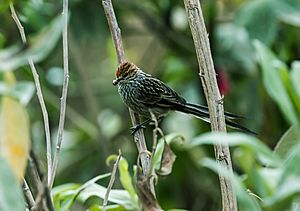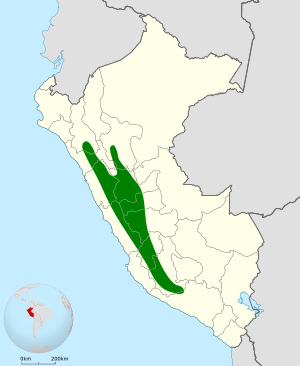Rusty-crowned tit-spinetail facts for kids
Quick facts for kids Rusty-crowned tit-spinetail |
|
|---|---|
 |
|
| Conservation status | |
| Scientific classification | |
| Genus: |
Leptasthenura
|
| Species: |
pileata
|
 |
|
The rusty-crowned tit-spinetail (Leptasthenura pileata) is a small, active bird. It belongs to the Furnariidae family, often called "ovenbirds" because some of them build unique, oven-shaped nests. This special bird lives only in Peru, which means it is endemic to that country.
You can find the rusty-crowned tit-spinetail in the high mountains of Peru. It prefers cool, moist forests and bushy areas. These places are often found at high altitudes, where the air is thin and the plants are unique.
Contents
What Does It Look Like?
This bird gets its name from the rusty, reddish-brown patch on top of its head, like a little crown. It is a small bird, but it has a long tail. Its body is mostly a dull brown or gray color, helping it blend in with the trees and bushes where it lives.
Where Does It Live?
The rusty-crowned tit-spinetail makes its home in the Andes Mountains of Peru. It lives in two main types of places:
- Montane Forests: These are forests found on the slopes of mountains. They are often moist and misty, with lots of trees and plants.
- High-Altitude Shrubland: This refers to areas with many bushes and shrubs, found at very high elevations. These places can be windy and cool.
This bird is very good at moving quickly through the dense branches and leaves. It uses its long tail to help it balance as it hops and flits around.
Why Is It Special?
Being endemic to Peru means that the rusty-crowned tit-spinetail cannot be found naturally anywhere else in the world. This makes it a very special part of Peru's wildlife. Protecting its habitat is important to make sure these unique birds continue to thrive.
Conservation Status
The rusty-crowned tit-spinetail is currently listed as "Least Concern" by the International Union for Conservation of Nature (IUCN). This means that its population is stable and not currently facing major threats. However, it is always important to protect natural habitats to ensure all species remain safe.
Images for kids
See also
 In Spanish: Tijeral coronado para niños
In Spanish: Tijeral coronado para niños




